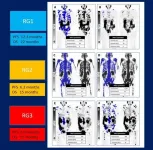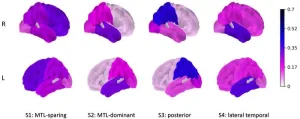(Press-News.org) Chicago, Illinois (Embargoed until 3:45 p.m. CDT, Tuesday, June 27, 2023)—By monitoring early-response biomarkers in men undergoing 177Lu-PSMA prostate cancer treatment, physicians can personalize dosing intervals, significantly improving patient outcomes. In a study presented at the Society of Nuclear Medicine and Molecular Imaging 2023 Annual Meeting, early stratification with 177Lu-SPECT/CT allowed men responding to treatment to take a “treatment holiday” and allowed those not responding the option to switch to another treatment.
Approved by the U.S. Food and Drug Administration in 2022, 177Lu-PSMA is an effective treatment for metastatic castration-resistant prostate cancer. However, not all men respond equally to treatment, with some responding very well and others progressing early.
“Currently, a standardized dosing interval is used for 177Lu-PSMA treatment,” said Andrew Nguyen, MBBS, FRACP, AANMS, senior staff specialist in the Department of Theranostics and Nuclear Medicine at St. Vincent's Hospital in Sydney, Australia. “However, monitoring early-response biomarkers to adjust treatment intervals may improve patient outcomes.”
In the study, researchers sought to evaluate progression-free survival and overall survival of different dosing intervals. Study participants included 125 men who were treated in a clinical program with six weekly doses of 177Lu-PSMA. The men were imaged with 177Lu-SPECT/CT after each dose. After the second dose, researchers analyzed the men’s prostate specific antigen (PSA) levels and the 177Lu-SPECT response to determine ongoing management.
Patients were grouped by level of response. Those in Response Group 1 (35 percent of participants) had a marked reduction in PSA level and partial response on 177Lu-SPECT and were advised to cease treatment until PSA levels rose. Response Group 2 (34 percent) saw stable or reduced PSA and stable disease on SPECT imaging; these men continued on their six week treatment plan until no longer clinically beneficial. In Response Group 3 (31 percent), men saw a rise in PSA levels and had progressive disease on SPECT imaging. These patients were offered the opportunity to try a different treatment.
PSA levels decreased by more than 50 percent in 60 percent of patients. Overall study participants had a median PSA progression-free survival of 6.1 months and a median overall survival of 16.8 months. Median PSA progression-free survival was 12.1 months, 6.1 months, and 2.6 months, for Response Groups 1, 2 and 3, respectively. The overall survival was 19.2 months for Response Group 1, 13.2 months for Response Group 2, and 11. 2 months for Response Group 3. Additionally, for those in Response Group 1 who had a “treatment holiday,” the median treatment-free time was 6.1 months.
“Personalized dosing allowed one-third of the men in this study to have treatment breaks while still achieving the same progression-free and overall survival outcomes they would have if they received continuous treatment,” noted Nguyen. “It also allowed another one-third of men who had early biomarkers of disease progression the opportunity to try a more effective potential therapy if one was available.”
Patients at St. Vincent's Hospital will continue to be stratified by these early response biomarkers. Once validated in a prospective clinical trial, Nguyen hopes that this stratification strategy will become more widely available for patients.
Abstract 507.“Patient outcomes following a response biomarker guided approach to treatment using 177Lu-PSMA-I&T in men with metastatic castrate resistant prostate cancer (Re-SPECT).” Louise Emmett, Sarennya Pathmanandavel, Maria Ayers, and Andrew Nguyen, Department of Theranostics and Nuclear Medicine, St. Vincent’s Hospital, Sydney, New South Wales, Australia; Nikeith John, William Counter, Aron Poole, Shikha Agrawal, and Lyn Chan, St. Vincent’s Hospital, Sydney, New South Wales, Australia; Peter Eu, Peter MacCallum Cancer Centre. Melbourne, Victoria, Australia; Megan Crumbaker, The Kinghorn Cancer Centre, St. Vincent’s Hospital, Sydney, New South Wales, Australia.
Link to Session
###
All 2023 SNMMI Annual Meeting abstracts can be found online.
About the Society of Nuclear Medicine and Molecular Imaging
The Society of Nuclear Medicine and Molecular Imaging (SNMMI) is an international scientific and medical organization dedicated to advancing nuclear medicine and molecular imaging—vital elements of precision medicine that allow diagnosis and treatment to be tailored to individual patients in order to achieve the best possible outcomes.
SNMMI’s members set the standard for molecular imaging and nuclear medicine practice by creating guidelines, sharing information through journals and meetings and leading advocacy on key issues that affect molecular imaging and therapy research and practice. For more information, visit www.snmmi.org.
END
Personalized dosing in prostate cancer treatment improves patient outcomes
2023-06-27
ELSE PRESS RELEASES FROM THIS DATE:
Genomics- and image-guided subtyping refines characterization of Alzheimer’s disease
2023-06-27
Chicago, Illinois (Embargoed until 4:05 p.m. CDT, Tuesday, June 27, 2023)—A new computational technique that combines genomic and tau PET imaging data promises a more personalized approach for subtyping Alzheimer’s disease. Based on a novel clustering framework using sparse canonical correlation analysis (SCCA), the integrated approach was successful in identifying four subtypes of Alzheimer’s disease and the top genes associated with each. This research was presented at the 2023 Society of Nuclear Medicine and Molecular Imaging Annual ...
A jaw-dropping conundrum: Why do mammals have a stiff lower jaw?
2023-06-27
From the 20-foot-long jawbones of the filter-feeding blue whale to the short, but bone-crushing, jaws of the hyena and the delicate chin bones of a human, the pair of lower jawbones characteristic of mammals have evolved with amazing variation.
But at first glance, having a single bone on each side of the head — which creates a stiff lower jaw, or mandible — doesn't appear to give mammals an advantage over other vertebrates, which have at least two and as many as 11 bones comprising each side of the lower jaw.
Crocodiles, for example, have an edge over hyenas when it comes to their bite strength relative to ...
New research by Sylvester Cancer shows unmet support needs can lead to worse clinical outcomes
2023-06-27
MIAMI, FLORIDA (June 27, 2023) – Cancer patients with unmet supportive care needs are more likely to experience worse clinical outcomes, including more emergency department (ED) visits and hospitalizations, according to new research from Sylvester Comprehensive Cancer Center at the University of Miami Miller School of Medicine.
The study, published June 21 in JAMA Network Open, also found that Black race, Hispanic ethnicity and factors such as anxiety, depression, pain, poor physical function and low health-related quality-of-life ...
Higher doses of oral semaglutide improves blood sugar control and weight loss
2023-06-27
CHAPEL HILL, N.C. – Diabetes is a progressive disease that affects one’s ability to control blood sugar levels. For many patients, the condition becomes more severe over time and blood sugar levels grow more difficult to manage. Glucagon-like peptide-1 (GLP-1) receptor agonists, such as semaglutide, have granted patients more control in lowering of blood sugar.
John Buse, MD, PhD, the Verne S. Caviness Distinguished Professor of Medicine in the Division of Endocrinology and Metabolism, and an international team of researchers have presented new findings about new higher-dose formulations ...
Age of those with mismatched biological sex and gender identity (gender dysphoria) is falling
2023-06-27
The age of those who are distressed because of a mismatch between their biological sex and their gender identity—known as gender dysphoria—has been steadily falling, reveals research published in the open access journal General Psychiatry.
And it’s lower for those assigned female sex at birth than those assigned male, the findings indicate.
Recent studies suggest that gender dysphoria is becoming more common, particularly among those assigned female sex at birth. But these studies have been hampered by small sample sizes, short monitoring periods, or outdated datasets.
In a bid to get round these limitations, the researchers drew on data submitted ...
Mediation’s role in parental disputes about child’s medical treatment may have been oversold
2023-06-27
The role of mediation in preventing disputes between parents and doctors about a seriously ill child’s medical treatment from escalating to litigation may be more limited than hoped for, suggests an analysis of rulings, published online in the Archives of Disease in Childhood.
It might have avoided only just under half of these published court cases heard since 1990 in England and Wales, the analysis suggests.
Contested medical treatment decisions for children litigated in the courts of England and Wales may be on the rise, say the researchers.
While 10 and 11 such ...
Ask us how to build the circular economy, say scientists
2023-06-27
Governments and companies planning to pursue the circular economy need to involve scientists more directly, states a new report published by the International Society for Industrial Ecology, and led by UCL’s Dr Stijn van Ewijk.
The report, published today, draws attention to the weight of relevant expertise found in the field of industrial ecology, a discipline that has been focusing on the minimisation of waste, predicting the impacts of new products, and designing environmentally friendly systems for decades.
The ...
DNA discovery may assist in fight against aggressive cancer
2023-06-27
In a significant development in the fight against fatal cancers, University of Otago researchers have pinpointed a key feature that leads to the aggressive spread of colon cancer.
Led by Associate Professor Aniruddha Chatterjee and Drs Euan Rodger and Rachel Purcell, researchers discovered abnormalities in the DNA instruction code that lead to the aggressive spread of colorectal (bowel) cancer – Aotearoa’s second highest cause of cancer death.
Dr Rodger says the finding – published in the Cell Press journal ...
Addressing health in areas characterized by persistent poverty
2023-06-27
The Center for Health Outcomes and Population Equity (HOPE) at Huntsman Cancer Institute and the University of Utah (the U), in partnership with the Montana State University Center for American Indian and Rural Health Equity (CAIRHE), received a grant for Cancer Control in Persistent Poverty Areas from the National Cancer Institute (NCI), part of the National Institutes of Health. The new grant is part of the National Cancer Moonshot, led by the Biden-Harris Administration, and it will bring together the expertise of the Center for HOPE and CAIRHE to expand their impact through two initiatives that ...
Toxic ideas online are spreading and growing through the use of irony, analysis shows
2023-06-26
Irony has become a medium for the spread of toxic ideas online, new analysis shows.
The use of irony is growing in both contemporary politics and radical online communities because it helps people to make sense of and navigate major political and economic changes, researchers have said.
Ideas, jokes, memes, images are emerging as an animating force for new social movements and are now inextricably intertwined with the rise of the alt-right.
The study says examining irony can help understand how recent influential political ...






